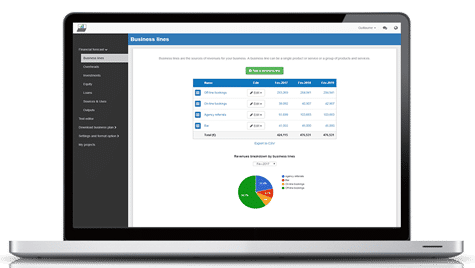How to create a financial forecast for a foundry?

If you are serious about keeping visibility on your future cash flows, then you need to build and maintain a financial forecast for your foundry.
Putting together a foundry financial forecast may sound complex, but don’t worry, with the right tool, it’s easier than it looks, and The Business Plan Shop is here to guide you.
In this practical guide, we'll cover everything you need to know about building financial projections for your foundry.
We will start by looking at why they are key, what information is needed, what a forecast looks like once completed, and what solutions you can use to create yours.
Let's dive in!
Why create and maintain a financial forecast for a foundry?
The financial projections for your foundry act as a financial blueprint to guide its growth with confidence and ensure its long-term financial viability.
To create them, you will need to look at your business in detail - from sales to operating costs and investments - to assess how much profit it can generate in the years to come and what will be the associated cash flows.
During challenging market conditions, maintaining an up-to-date financial forecast enables early detection of potential financial shortfalls, allowing for timely adjustments or securing financing before facing a cash crisis.
Your foundry's financial forecast will also prove invaluable when seeking financing. Banks and investors will undoubtedly request a thorough examination of your financial figures, making precision and presentation essential.
Need a solid financial forecast?
The Business Plan Shop does the maths for you. Simply enter your revenues, costs and investments. Click save and our online tool builds a three-way forecast for you instantly.
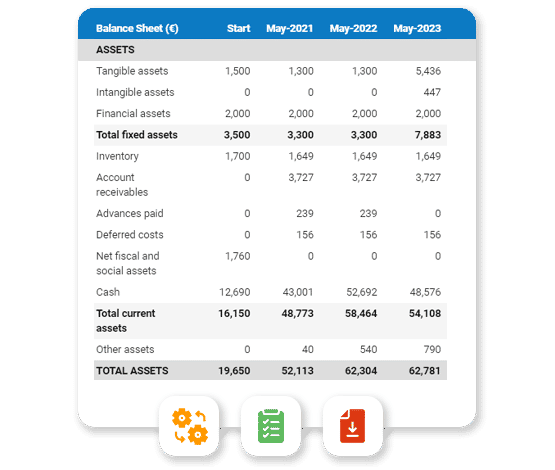
What information is needed to build a foundry financial forecast?
The quality of your inputs is key when it comes to financial modelling: no matter how good the model is, if your inputs are off, so will the forecast.
If you are building a financial plan to start a foundry, you will need to have done your market research and have a clear picture of your sales and marketing strategies so that you can project revenues with confidence.
You will also need to have a clear idea of what resources will be required to operate the foundry on a daily basis, and to have done your research with regard to the equipment needed to launch your venture (see further down this guide).
If you are creating a financial forecast of an existing foundry, things are usually simpler as you will be able to use your historical accounting data as a budgeting base, and complement that with your team’s view on what lies ahead for the years to come.
Let's now zoom in on what will go in your foundry's financial forecast.
The sales forecast for a foundry
From experience, it usually makes sense to start your foundry's financial projection with the revenues forecast.
The inputs used to forecast your sales will include the historical trading data of your foundry (which can be used as a starting point for existing businesses) and the data collected in your market research (which both new ventures and existing businesses need to project their sales forward).
Your foundry's sales forecast can be broken down into two key estimates:
- The average price
- The number of monthly transactions
To assess these variables accurately, you will need to consider the following factors:
- Changes in raw material prices: Fluctuations in the cost of raw materials, such as iron, steel, and aluminum, can impact the average price of your foundry's products. Keep an eye on market trends and adjust your prices accordingly to maintain profitability.
- Demand for specific products: The demand for certain products, such as iron castings or steel forgings, can vary over time. Monitor customer needs and market trends to stay ahead of changing demand and adjust your production accordingly.
- Competition: The presence of other foundries in your area can affect the number of monthly transactions for your business. Keep an eye on your competitors' pricing and offerings to ensure you remain competitive in the market.
- Changes in technology: Advancements in technology can impact the efficiency of your foundry and, in turn, affect your average price and number of monthly transactions. Stay up-to-date with new technologies and invest in them when necessary to stay ahead of the competition.
- Economic conditions: Economic downturns or upswings can have a significant impact on the average price and number of monthly transactions for your foundry. Keep an eye on the overall economic climate and adjust your sales forecast accordingly.
Once you have a sales forecast in place, the next step will be to work on your overhead budget. Let’s have a look at that now.
Need inspiration for your business plan?
The Business Plan Shop has dozens of business plan templates that you can use to get a clear idea of what a complete business plan looks like.

The operating expenses for a foundry
The next step is to estimate the costs you’ll have to incur to operate your foundry.
These will vary based on where your business is located, and its overall size (level of sales, personnel, etc.).
But your foundry's operating expenses should normally include the following items:
- Staff Costs: This includes salaries, wages, and benefits for employees working in the foundry such as machine operators, supervisors, and administrative staff.
- Accountancy Fees: You will need to hire an accountant to manage your financial records, prepare taxes, and provide financial advice for your foundry.
- Insurance Costs: You will need to secure insurance coverage for your foundry to protect against potential risks and liabilities.
- Software Licences: You will need to purchase software licenses for various programs and applications used in the operation of the foundry, such as CAD software.
- Banking Fees: You will incur fees for banking services such as wire transfers, check processing, and maintaining bank accounts for your foundry.
- Raw Materials: This includes the cost of purchasing raw materials such as metal alloys, sand, and chemicals used in the foundry process.
- Energy Costs: Foundries require a significant amount of energy to operate, so you will need to account for expenses such as electricity, gas, and fuel.
- Rent or Mortgage: If you do not own the building where your foundry is located, you will need to pay rent. If you own the building, you will have mortgage payments.
- Maintenance and Repairs: Regular maintenance and repairs are crucial to keep your equipment and machinery in good working condition, and these costs should be included in your forecast.
- Marketing and Advertising: To attract new customers and promote your foundry, you may need to spend money on marketing and advertising efforts.
- Professional Services: You may need to hire outside professionals, such as lawyers or consultants, to help with specific aspects of your foundry's operations.
- Taxes and Permits: Foundries are subject to various taxes, including property taxes and sales taxes, as well as fees for permits and licenses.
- Training and Development: To ensure your employees have the necessary skills and knowledge to perform their jobs, you may need to invest in training and development programs.
- Transportation and Shipping: If your foundry ships products to customers, you will need to account for costs such as transportation, packaging, and shipping fees.
- Safety and Compliance: Operating a foundry comes with certain safety and compliance requirements, which may include training, equipment, and inspections.
This list is not exhaustive by any means, and will need to be tailored to your foundry's specific circumstances.
What investments are needed to start or grow a foundry?
Once you have an idea of how much sales you could achieve and what it will cost to run your foundry, it is time to look into the equipment required to launch or expand the activity.
For a foundry, capital expenditures and initial working capital items could include:
- Industrial Furnace
- Molding Machine
- Casting Equipment
- Melting Furnace
- Sand Mixer
Again, this list will need to be adjusted according to the specificities of your foundry.
Need a convincing business plan?
The Business Plan Shop makes it easy to create a financial forecast to assess the potential profitability of your projects, and write a business plan that’ll wow investors.
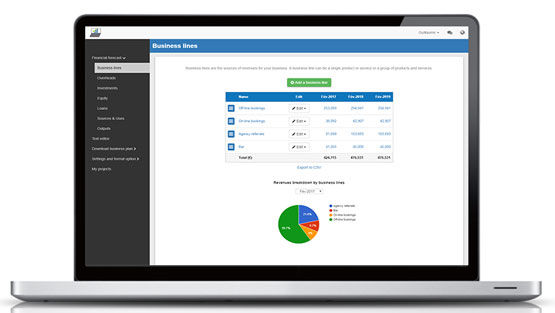
The financing plan of your foundry
The next step in the creation of your financial forecast for your foundry is to think about how you might finance your business.
You will have to assess how much capital will come from shareholders (equity) and how much can be secured through banks.
Bank loans will have to be modelled so that you can separate the interest expenses from the repayments of principal, and include all this data in your forecast.
Issuing share capital and obtaining a bank loan are two of the most common ways that entrepreneurs finance their businesses.
What tables compose the financial plan for a foundry?
Now let's have a look at the main output tables of your foundry's financial forecast.
The projected profit & loss statement
The projected profit & loss shows how profitable your foundry is likely to be in the years to come.
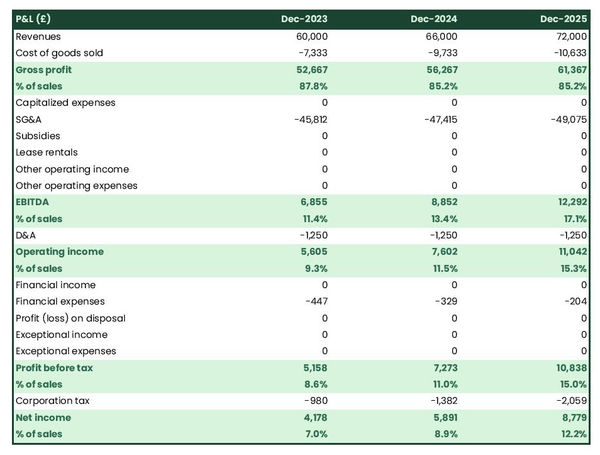
For your foundry to be financially viable, your projected P&L should ideally show:
- Sales growing above inflation (the higher the better)
- Profit margins which are stable or expanding (the higher the better)
- A net profit at the end of each financial year (the higher the better)
This is for established foundrys, there is some leniency for startups which will have numbers that will look a bit different than existing businesses.
The projected balance sheet
Your foundry's projected balance sheet provides a snapshot of your business’s financial position at year-end.
It is composed of three types of elements: assets, liabilities and equity:
- Assets: represent what the business possesses including cash, equipment, and accounts receivable (money owed by clients).
- Liabilities: represent funds advanced to the business by lenders and other creditors. They include accounts payable (money owed to suppliers), taxes payable and loans from banks and financial institutions.
- Equity: is the combination of what has been invested by the business owners and the cumulative profits and losses generated by the business to date (which are called retained earnings). Equity is a proxy for the value of the owner's stake in the business.
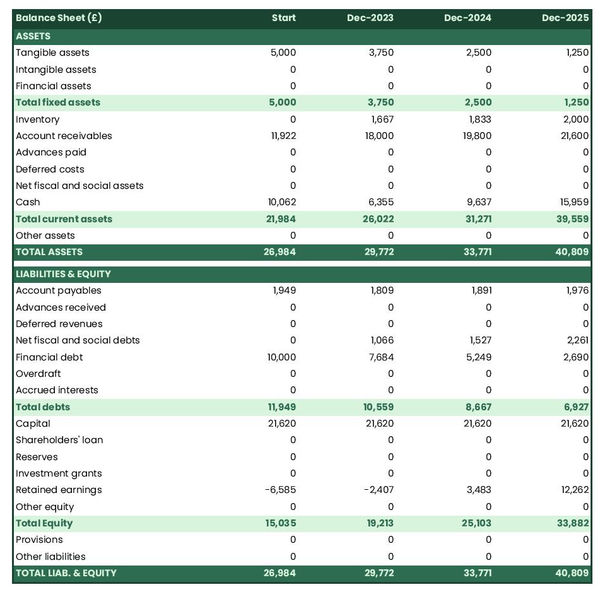
The cash flow forecast
Your foundry's cash flow forecast shows how much cash your business is expected to consume or generate in the years to come.

It is best practice to organise the cash flow forecast by nature to better explain where cash is used or generated by the foundry:
- Operating cash flow: shows how much cash is generated by the operating activities
- Investing cash flow: shows how much will be invested in capital expenditure to maintain or expand the business
- Financing cash flow: shows if the business is raising new capital or repaying financiers (debt repayment, dividends)
Keeping an eye on (and regularly updating) your foundry's cash flow forecast is key to ensuring that your business has sufficient liquidity to operate normally and to detect financing requirements as early as possible.
If you are trying to raise capital, you will normally be asked to provide a monthly cash flow forecast in your foundry's financial plan - so that banks or investors can assess seasonal variation and ensure your business is appropriately capitalised.
Need a solid financial forecast?
The Business Plan Shop does the maths for you. Simply enter your revenues, costs and investments. Click save and our online tool builds a three-way forecast for you instantly.

Which tool should you use to create your foundry's financial projections?
Building a foundry financial forecast is not difficult provided that you use the right tool for the job. Let’s see what options are available below.
Using online financial forecasting software to build your foundry's projections
The modern and easiest way is to use an online financial forecasting tool such as the one we offer at The Business Plan Shop.
There are several advantages to using specialised software:
- You can easily create your financial forecast by letting the software take care of the financial calculations for you without errors
- You have access to complete financial forecast templates
- You get a complete financial forecast ready to be sent to your bank or investors
- You can easily track your actual financial performance against your financial forecast, and recalibrate your forecast as the year goes by
- You can create scenarios to stress test your forecast's main assumptions
- You can easily update your forecast as time goes by to maintain visibility on future cash flows
- You have a friendly support team on standby to assist you when you are stuck
- It’s cost-efficient and much cheaper than using an accountant or consultant (see below)
If you are interested in this type of solution, you can try our projection software for free by signing up here.
Hiring a financial consultant or chartered accountant
Hiring a consultant or chartered accountant is also an efficient way to get a professional foundry financial projection.
As you can imagine, this solution is much more expensive than using software. From experience, the creation of a simple financial forecast over three years (including a balance sheet, income statement, and cash flow statement) is likely to start around £700 or $1,000 excluding taxes.
The indicative estimate above, is for a small business, and a forecast done as a one-off. Using a financial consultant or accountant to track your actuals vs. forecast and to keep your financial forecast up to date on a monthly or quarterly basis will naturally cost a lot more.
If you choose this solution, make sure your service provider has first-hand experience in your industry, so that they may challenge your assumptions and offer insights (as opposed to just taking your figures at face value to create the forecast’s financial statements).
Why not use a spreadsheet such as Excel or Google Sheets to build your foundry's financial forecast?
Creating an accurate and error-free foundry financial forecast on Excel (or any spreadsheet) is very technical and requires both a strong grasp of accounting principles and solid skills in financial modelling.
Most entrepreneurs lack the expertise required to create an accurate financial forecast using spreadsheet software like Excel or Google Sheets. As a result, it is unlikely anyone will trust your numbers.
The second reason is that it is inefficient. Building forecasts on spreadsheets was the only option in the 1990s and early 2000s, nowadays technology has advanced and software can do it much faster and much more accurately.
This is why professional forecasters all use software. With the rise of AI, software is also becoming smarter at helping us detect mistakes in our forecasts and helping us analyse the numbers to make better decisions.
Finally, like everything with spreadsheets, tracking actuals vs. forecasts and updating your forecast as the year progresses is manual, tedious, error-prone, and time-consuming. Whereas financial forecasting software like The Business Plan Shop is built for this.
Need a convincing business plan?
The Business Plan Shop makes it easy to create a financial forecast to assess the potential profitability of your projects, and write a business plan that’ll wow investors.

Use our financial projection templates for inspiration
The Business Plan Shop has dozens of financial forecasting templates available.
Our examples contain both the financial forecast, and a written business plan which presents, in detail, the company, the team, the strategy, and the medium-term objectives.
Whether you are just starting out or already have your own foundry, looking at our template is always a good way to get ideas on how to model financial items and what to write when creating a business plan to secure funding.

Takeaways
- A financial forecast shows expected growth, profitability, and cash generation metrics for your foundry.
- Tracking actuals vs. forecast and having an up-to-date financial forecast is key to maintaining visibility on your future cash flows.
- Using financial forecasting software is the modern way of creating and maintaining financial projections.
We hope that this guide helped you gain a clearer perspective on the steps needed to create the financial forecast for a foundry. Don't hesitate to contact us if you have any questions!
Need inspiration for your business plan?
The Business Plan Shop has dozens of business plan templates that you can use to get a clear idea of what a complete business plan looks like.

Also on The Business Plan Shop
Know someone who runs a foundry? Share our business guide with them!

